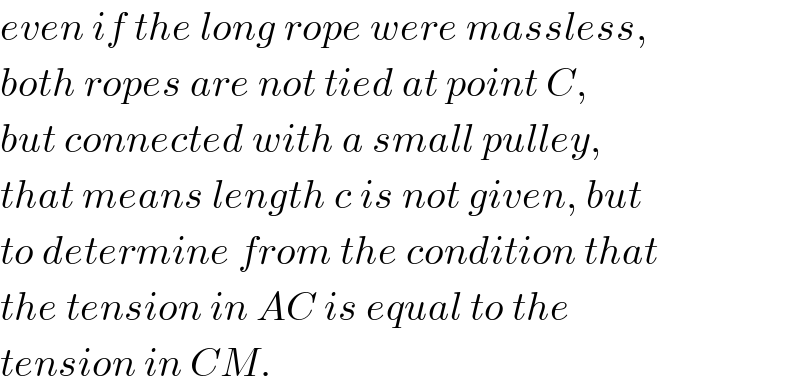
Question and Answers Forum
Question Number 98461 by mr W last updated on 14/Jun/20

Commented by mr W last updated on 14/Jun/20

Answered by 1549442205 last updated on 14/Jun/20

Commented by 1549442205 last updated on 15/Jun/20
![Suppose that the rope L is tied at the end C so that AC=c.Then from Herong′s formula we have h_c =(2/b)(√(p(p−a)(p−b)(p−c))) ,where p=((a+b+c)/2).From that cos MCH^(�) =cosBCD^(�) =(h_c /a) i)Consider the case that a^2 +c^2 =b^2 we have cosMCH^(�) =cosBAC^(�) =(c/b)=((√(a^2 −b^2 ))/b).Henxe, The tension of the rope BC is T=CH=CM.cosMCH^(�) =(M+m)g.((√(b^2 −a^2 ))/b)(m−the mass of the rope L) ii)The case L≥c≥a^2 +b^2 then T=(M+m)g because CB⊥AB ]](Q98563.png)
Commented by mr W last updated on 14/Jun/20

Commented by mr W last updated on 14/Jun/20

Answered by mr W last updated on 15/Jun/20

Commented by mr W last updated on 15/Jun/20
![case m=0, i.e. long rope massless 2β+(π/2)−α=π ⇒α=2β−(π/2) (a/(sin α))=(b/(sin (α+(π/2)−β))) −(a/(cos 2β))=(b/(sin β)) −(a/(1−2 sin^2 β))=(b/(sin β)) 2 sin^2 β−(a/b) sin β−1=0 ⇒sin β=(1/4)[(a/b)+(√(((a/b))^2 +8))] T_C =Mg T=2T_C cos β ⇒T=2Mg (√(1−(1/(16))[(a/b)+(√(((a/b))^2 +8))]^2 ))](Q98647.png)
Answered by mr W last updated on 15/Jun/20

Commented by mr W last updated on 15/Jun/20

Commented by mr W last updated on 16/Jun/20
![in this case the rope section AC is a part of the catenary. y=h cosh (x/h) with h=(T_0 /(ρg))=((T_C cos α)/(ρg)) and ρ=(m/L) α=(π/2)−2β tan α=y′=sinh (e/h)=(1/(tan 2β)) ⇒e=h sinh^(−1) (1/(tan 2β)) f=h cosh (e/h)=h cosh (sinh^(−1) (1/(tan 2β))) c=b−a sin β−e=b−a sin β−h sinh^(−1) (1/(tan 2β)) rope length AE^(⌢) =s_1 s_1 =h sinh (c/h)=h sinh (((b−a sin β)/h)−sinh^(−1) (1/(tan 2β))) rope length EC^(⌢) =s_2 s_2 =h sinh (e/h)=(h/(tan 2β)) rope length CD=s_3 s_3 =L−s_1 −s_2 s_3 =L−h sinh (((b−a sin β)/h)−sinh^(−1) (1/(tan 2β)))−(h/(tan 2β)) T_C =Mg+ρgs_3 T_C =Mg+ρg[L−h sinh (((b−a sin β)/h)−sinh^(−1) (1/(tan 2β)))−(h/(tan 2β))] T_C =(M+m)g−hρg[ sinh (((b−a sin β)/h)−sinh^(−1) (1/(tan 2β)))+(1/(tan 2β))] ((hρg)/(sin 2β))=(M+m)g−hρg[ sinh (((b−a sin β)/h)−sinh^(−1) (1/(tan 2β)))+(1/(tan 2β))] ((1+cos 2β)/(sin 2β))=(((M+m)L)/(mh))−sinh (((b−a sin β)/h)−sinh^(−1) (1/(tan 2β))) ⇒sinh (((b−a sin β)/h)−sinh^(−1) (1/(tan 2β))) =(((M+m)L)/(mh))−((1+cos 2β)/(sin 2β)) ...(i) d=f+a cos β h cosh (c/h)=h cosh (sinh^(−1) (1/(tan 2β)))+a cos β ⇒cosh (((b−a sin β)/h)−sinh^(−1) (1/(tan 2β)))=cosh (sinh^(−1) (1/(tan 2β)))+(a/h) cos β ...(ii) ⇒[cosh (sinh^(−1) (1/(tan 2β)))+(a/h) cos β]^2 −[(((M+m)L)/(mh))−((1+cos 2β)/(sin 2β))]^2 =1 ⇒[cosh (sinh^(−1) (1/(tan 2β))) h+a cos β]^2 −[(((M+m)L)/m)−(((1+cos 2β)/(sin 2β)))h]^2 =h^2 ⇒[cosh (sinh^(−1) (1/(tan 2β)))]^2 h^2 +a^2 cos^2 β+2a cos β cosh (sinh^(−1) (1/(tan 2β)))h−[(((M+m)L)/m)]^2 −(((1+cos 2β)/(sin 2β)))^2 h^2 +2(((1+cos 2β)/(sin 2β)))(((M+m)L)/m)h=h^2 ⇒(((1+2 cos 2β)/(sin^2 2β)))h^2 −(1/(sin β))[a(√(1+cos^2 2β))+(((1+cos 2β)/(cos β)))((M/m)+1)L]h+[(((M+m)L)/m)]^2 −a^2 cos^2 β=0 ...(iii) from (iii) we get h in terms of β. put this into (i) or (ii) we get β. T_C =((ρgh)/(sin 2β)) ⇒T=2T_C cos β=((ρgh)/(sin β))](Q98745.png)
